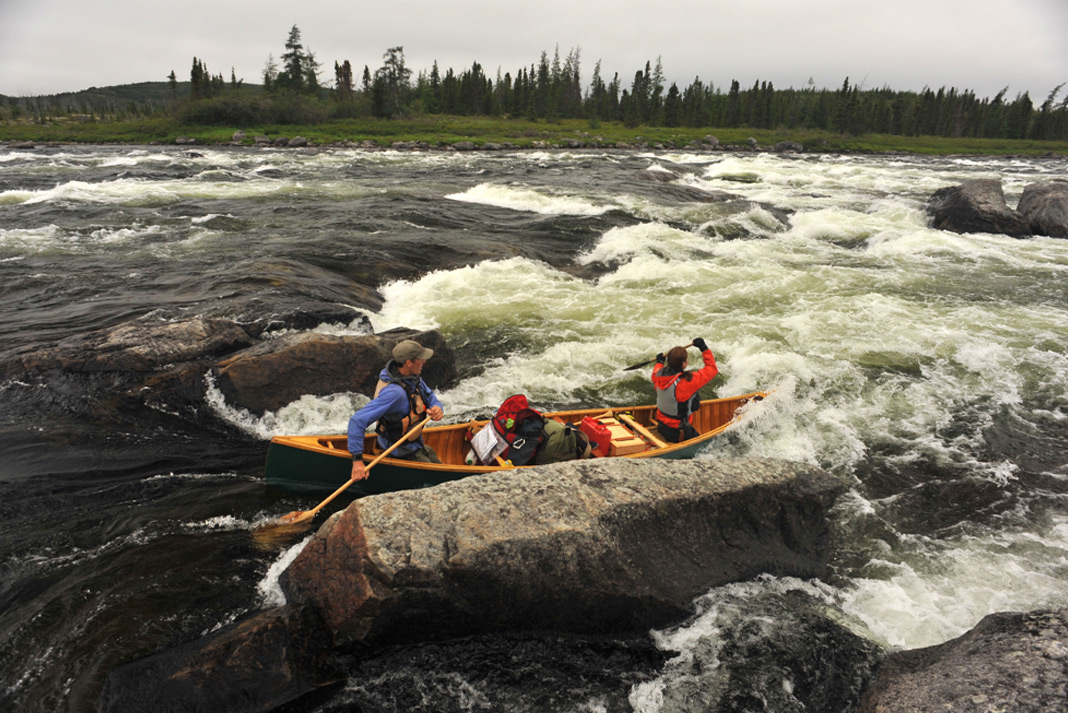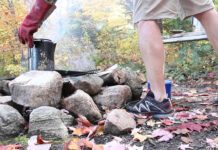There’s no time to hesitate in the rapids of this steep, shallow, unnamed river, deep in the wilderness of northern Quebec. But my wife Kim and I did just that, second-guessing our line in a narrow chute and coming to a sudden stop on a rounded rock, with the current racing by. The mid-section of our canoe bowed inwards and our packs crested the gunwales, just as I catapulted from the stern in a desperate effort to avoid wrapping around the boulder. Such a moment would be a harrowing near-miss in a plastic canoe, but we’re two weeks into a 45-day trip—paddling a gorgeous wood-canvas canoe.
Later, when I relate this story to Hugh Stewart, the craftsman who built my beloved Headwaters 17-foot Prospector, he merely shrugs. Maybe we should’ve scouted the rapid better, he intones.
Stewart has spent a lifetime combatting the fragility myth of wood-canvas canoes. His passion for Canadian history and his extensive travels throughout the Far North demonstrate canoes like mine were designed for hard use—long before the space age and its so-called indestructible canoes. Aesthetics are one thing, but wood-canvas canoes are particularly easy to maintain on the trail and meant to be rebuilt. My Prospector has been through thousands of kilometers of hard wilderness travel, including powerful whitewater rivers and shallow streams, its hull kept up with a small repair kit and a bit of know-how.
That night in northern Quebec, I flipped the canoe and inspected the canvas—something I habitually do almost every day. Impacts with rocks can rub through the waterproof filler or may puncture or cut the skin altogether. Stewart notes that most damage often occurs when a partially-floating canoe rubs onshore over a lunch break or while its paddlers inspect a rapid or portage trail.
The antidote to worn or torn canvas is a contact adhesive—Ambroid is the traditional staple, but since this hobby store glue was discontinued, it has been replaced with generic contact cement or butyrate (also known as airplane dope, used in the construction of fabric-covered aircraft). Simply smearing a little on the canvas plasticizes the filler and waterproofs thin spots.
Larger tears require contact adhesive and a patch; a piece of cotton bandana cut to cover the hole and saturated with glue works well. Long-lasting repairs require dry canvas, so wait until the canoe has time to dry at the end of the day. “Burning on a patch” is a quick method of repairing torn canvas on a wet canoe: smear adhesive on the canoe and light it on fire, promptly drying the canvas. Then cut and apply a patch. Contact adhesive dries quickly and the canoe will be serviceable in mere minutes.
Occasionally, impact with a rock will fracture the canoe’s planking; a hard hit may even break ribs—you’ll know when this happens because it sounds like gunfire. Often this sort of damage is merely cosmetic. But sometimes it requires immediate attention—like last summer, on the coast of Hudson Bay, when powerful winds cartwheeled a friend’s brand-new canoe across the bouldery tide flats, leaving its innards a splintery mess.
The repair was daunting, but we had plenty of time to work on it while the wind continued to blow. We started by carefully pushing and levering the broken cedar frame into a facsimile of its original shape. Then, I emptied my repair kit of the squares of tin I pre-cut at home (scraps of galvanized heating duct work well) to shore-up busted planking (the longitudinal strips of wood that comprise the hull), wedging the metal between the ribs. Broken ribs are usually strong enough to maintain a canoe’s shape, but if necessary, they can later be reinforced with a piece of wood spanning the break—a repair best done at home.
Stewart’s stepsons once completed an impressive field repair using lengths of split saplings to reinforce broken gunwales and a piece of birchbark to patch a massive tear in the canvas—salvaging a canoe that was wrapped around a rock on Quebec’s Moisie River.
The beauty is, back in the workshop, a well-used or badly damaged wood-canvas canoe can be fully restored, its canvas stripped to replace broken parts and rebuilt to look and function like new.
Conor Mihell is an award-winning environmental and adventure travel writer based in Sault Ste. Marie, Ontario. He disappears into the wilds of Nunavik each summer in his wood-canvas canoe.
Is wood-canvas the toughest expedition canoe you’ve never paddled? Maybe, says writer Conor Mihell. | Featured photo: Virginia Marshall








